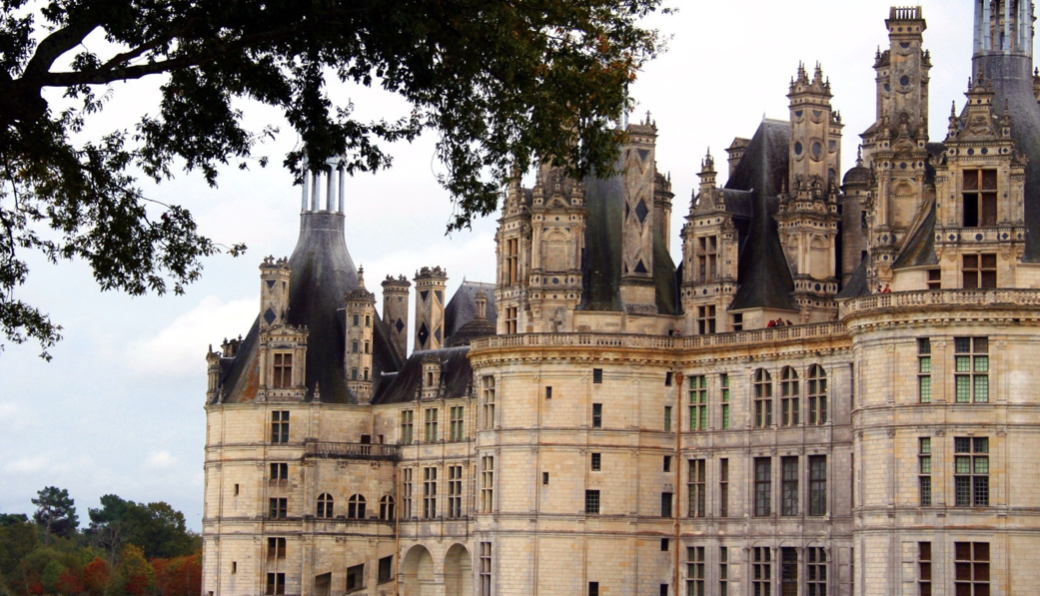With its world-famous greatest monuments, France is the world’s leading tourist country. The country welcomes more than 80 million visitors every year and amazes with the beauty and diversity of its landscapes, its many monuments steeped in history and culture, but also with its countless culinary specialities.
Visiting these greatest monuments of France is a reason why you should learn French.
Are you ready for a tour ?
The Palace of Versailles
In 1651, Louis XIV decided to use the former hunting lodge of his father Louis XIII to take his mistress. The King decided to build a royal residence in Versailles, far from the capital and the people of Paris, whom he distrusted. He moved there definitively in 1682.
The Château is famous for its Hall of Mirrors, its fountains, its gardens, its orangery, the Hameau de la Reine Marie-Antoinette… For more than a century, the palace will remain the residence of the kings of France. After the French Revolution, people totally abandoned the palace.
Now a museum, it was, during the 20th century, the place where the French presidency received guests during major diplomatic visits. Definitely the greatest monument of France.
The City of Carcassonne
This ancient city is a group of buildings from the mediaeval period. Carcassonne is located south-west of the city of the same name. It has a 3 kilometre long city wall. There is also a castle and the basilica of Saint-Nazaire.
The site overlooks Carcassonne, at an altitude of 150 metres, on a plateau. This height had the advantage of limiting attacks since the western slope was very steep.
The place has been inhabited since Antiquity. In the Middle Ages, the Counts of Carcassonne ruled the city and built a cathedral in the 11th century. Today, the Cité is a UNSECO World Heritage Site.
The Arena of Nîmes
Another testimony of the ancient times. The construction dates back to the 50s and 100s AD. 24,000 spectators could be seated in 34 rows of bleachers. The front seats were reserved for Roman notables. It was already intended for the organisation of shows for the population of Nîmes, such as gladiatorial combats.
In the Middle Ages, the monument was transformed into a fortress, providing a refuge for the population in case of danger. In 1809, houses, chapels and the castle of the Viscounts of Nîmes were demolished to restore the monument to its former appearance and make it one of the greatest of all.
The Haut-Koenigsbourg Castle
We are going to Alsace now. They built the Haut-Koenigsbourg in the 12th century. This fortress of almost 300 meters long, perched at about 800 meters high is one of the most emblematic monuments of France. Dominating the Alsace plain, the Haut-Koenigsbourg has all the assets of a fortress: a strategic position, relatively easy to defend in the past and today an exceptional panorama of the Alsace plain, the Vosges, the Black Forest and sometimes even the Alps.
Built by Hohenstaufen and then abandoned, it was later offered by the town of Sélestat to Emperor William II. The walk is long between the festival halls, the flats, the gardens, the dungeons… Don’t miss the restaurant which offers you the unique gastronomy of the Middle Ages!
The Mont Saint-Michel
Mont Saint-Michel is a small mountain in the middle of the sea. The construction of a religious sanctuary dedicated to Saint Michael began in 709. The name of the mountain was then changed, as it was previously called “Mont tombe”. The surrounding bay was also renamed after the saint honoured here. At low tide, you can walk to it.
Visit the bay, the old streets, the museums, the cathedral… and take advantage of the experience of a guide to see as much as possible!
You can also enjoy outdoor activities, parachuting, paragliding… On the water, with river kayaking and ferry crossings.
The Palais des Papes, in Avignon
During the Middle Ages, Popes left the Vatican to settle in France. To welcome them, a grandiose palace, the Palais des Papes, was built in the heart of the city. Also a UNESCO World Heritage Site since 1995, this historic French monument now offers the public a visit to the sumptuous and richly decorated private flats of the Popes. The palace also hosts events throughout the year: exhibitions, themed tours, concerts. The main courtyard of the Palais des Papes hosts a few performances during the Avignon theatre festival in July each year.
The Hospices de Beaune
We leave for the Burgundy region with the Hospices de Beaune, a mediaeval hospital foundation and one of France’s most prestigious historical monuments. Its gothic architecture and renowned vineyards make this place an emblem of France. Its history began in 1443: Beaune was emerging from the 100-year war and a plague epidemic. It was therefore decided to build this monument to help care for the most destitute.
Today, it is a museum. You won’t miss any of its patients’ rooms, the ancient medical tools, the gardens and the large courtyard. You will also be amazed by the colour of its roofs… The wines of the Hospices de Beaune are auctioned every third Sunday in November. And the funds raised during this annual sale go to charity!
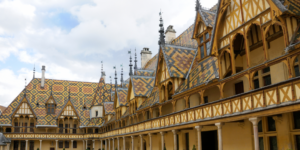
The Père Lachaise Cemetery
It’s not really a monument, but it’s a place to discover when you are in Paris. At first, it was a small classical cemetery. Later, after the transfer of the bodies of both famous French classic writers Molière and Jean de La Fontaine, many personalities were buried there. Père-Lachaise Cemetery, “the eastern cemetery”, is the largest cemetery in Paris and covers 43 hectares. It is a unique place that invites you to meditate and dream, steeped in art, culture and history, where you can travel through a maze of stones and vegetation.
More than 3 million visitors from all over the world visit it every year. Today it is a real open-air museum, with graves made for artists: Oscar Wilde, Jim Morrison …
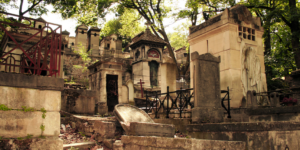
Notre-Dame de la Garde, Marseille
Another of France’s great religious monuments, the Basilica of Notre-Dame de la Garde is built on top of a limestone hill. The church dominates the Old Port of Marseille. It is the greatest monument and symbol of the city, nicknamed “the good mother” by its inhabitants.
In the 19th century, the architect Henri Espérandieu designed it in a Romanesque-Byzantine style. A 11 meter statue of the Virgin and Child sits on the top of the bell tower. The colour is given by its gilded copper cladding, which makes it a very exotic monument in the heart of France.
Chambord Castle
Let’s go to the Loire River. The Chambord castle was commissioned by King Francis I of France. Leonardo da Vinci designed the double spiral staircase.
Chambord is a radically unique work of art, one of the jewels of humanity’s heritage. Its vocation is symbolic, aesthetic and spiritual. It is an affirmation of royal power but also an evocation of an ideal city. Come and lose yourself in the staircases, galleries, terraces, large rooms and small cabinets which are all a pleasure.
On the garden side? The king asked to regulate the course of the river throughout the park and to divert part of the waters of the Loire to the foot of the castle. These projects never saw the light of day. But one thing is for sure, you will love to walk there, inside one of the greatest monuments of France…
The Promenade des Anglais, in Nice
The Promenade des Anglais, called the Prom’ by the locals, has a long history. In the 18th century, Nice became a winter resort by wealthy Englishmen. Most of them settled in houses along the Route de France, between the Magnan and the Paillon, or in the Buffa district, nicknamed the “Newborough” or “Little London”. But they complained about not having a practical, innovative and healthy promenade along the seafront.
After the First World War, the new mayor of Nice, Jean Médecin, decided to give the Promenade a new dimension. In 1931-1932, the lane reserved for cars was doubled, a five-metre strip of plants and palm trees separated them, and new street furniture was created and installed (luminous fountains, candelabras)… Today, more modern than ever, it is the meeting place for thousands of visitors and locals every year.
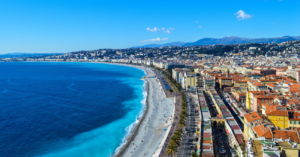
The Place Stanislas, in Nancy
In 1983, the Unesco World Heritage inscribed the ensemble comprising the Place Stanislas, the Place de la Carrière and the Place d’Alliance on its list.
Picture the Place Stanislas in the heart of the historic city centre. Imagine the construction, between 1751 and 1755.
But, le place has not always been called that. Initially people named it “Place entre les Deux Villes”, then “Place Royale” in 1792. It became the “Place du Peuple” in 1792 during the Revolution, before finally taking the name “Place Stanislas” in 1831 after Stanislas Leszczynski (1677-1766), King of Poland and father-in-law of Louis XV.
In 2021, French people elected Place Stanislas the most beautiful square in the world .
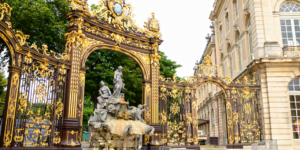
La Petite France, in Strasbourg
Take a long walk through the picturesque Petite France district, a mediaeval quarter, and note the old timber-framed houses. Stroll along the canals to enjoy the historic atmosphere. There are also tours if you want to learn more. You’ll encounter the Ill River, the Place Benjamin Zix, the Rue du Bain-aux-Plantes… and its many covered bridges.
A panoramic terrace offers a magnificent view of the Ponts Couverts, Petite France and the cathedral on one side, and the Museum of Modern Art on the other.
The Big Clock of Rouen
The Gros Horloge is a Renaissance pavilion. Under the number VI, a deity symbolising the day of the week appears at noon on a triumphal chariot.
Above the dial, a globe indicates the phases of the moon. The Paschal lamb, represented in the centre of the archway, symbolises the city’s arms. Finally, a Louis XV style fountain completes the ensemble. Don’t forget to cross its arch to discover more sculptures.
A tour organised by the city of Rouen reveals the mechanisms of the machine. In the pavilion, you can access the dial room and in the belfry. You can discover the 14th century mechanism, the first municipal bells and a unique panorama of the city of Rouen.
What about yours?
These greatest monuments include religious places, mediaeval castles and ancient citadels that have become important historical sites in France. There are several criterias for registering a monument as a historical monument of a city: the physical presentation of these buildings, the architecture of the construction or the style of construction are all part of the selection.

